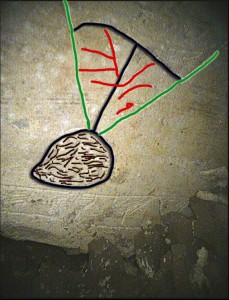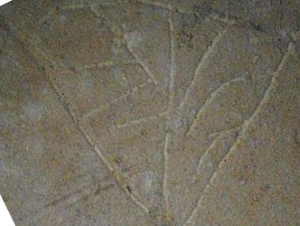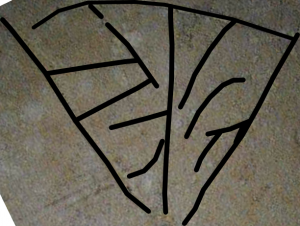“According to Prof. Charlesworth the tiny little “stick figure” that has been interpreted as a “Jonah” image by some, appears to be ingeniously formed so that its lines spell out the name YONAH in Hebrew—Yod, Vav, Nun, Hey” – Dr. James Tabor
So… where I am tempted to take a drive down to Princeton and knock on Dr. Charlesworth’s office door I feel that enough people will be doing that already when this debacle really gets underway.
So where to begin then?
Is the name Yonah “ingeniously formed” with the stick figure with a seaweed wrapped head? I am skeptical about this ossuary bearing any such name.
 |
| Image originally posted on TaborBlog. At least he’s showing that the “head” is a half-sphere. |
Ok, so here’s the image on Dr. Tabor’s blog where he reveals the name יונה. Let me extract it and rotate it so it’s more in a line:
Provided that it is a faithful representation of what is actually *on* the ossuary and we understand that the engraver was in no ways a professional, this could “pass” as the name Jonah if there were no better context to dictate otherwise.
However, does it faithfully represent what is on the ossuary?
I do not think so, much in the same way that a of a lot of the multimedia released about this find (images, the reproductions, video clips) does not faithfully reproduce elements of the inscription.
In fact, I think that “Jonah” being here is more of an exercise of reading tea leaves (or in this case, nests of scratches).
Here is the sum total of scratches “below the hip” of the diagram:
 |
| As it appears in the photograph. |
 |
| Lines outlined. |
They don’t quite match up with the “Jonah” inscription. In order to get that nice diagram above, there are several rules that have to be observed:
Rule 1: The entire inscription can be rotated in order to make sense of it.
Rule 2: Lines that are close can be joined to form letters.
Rule 3: Lines that are close can also be disconnected to form letters.
Rule 4: “Extra lines” can be ignored.
In my next post, I’ll go over a number of other names and words that can be extracted from this mess of lines by following these four simple rules.
Peace,
-Steve



BRILLIANT!
This comment has been removed by the author.
Sorry. I somehow posted that one wrong, trying again here…
Well Steve, what is really funny here, or maybe not “funny” “funny” but odd, is that at the end of the day, even when you highlight the very faint marks that are not part of the etching, the dominant marks stand out and clearly spell either YONAH or ZONAH or maybe ZELAH…take your pick. It is plain as the Aramaic on your face and I think you surely know it. These are not random marks and Cargill’s pictures of vase bottoms with the straight lines, taken from Hellenistic period kraters, is absurd. Nothing at all like this image. Also, just think, who does everyone go to for readings of this type if not Robert Deutsch, including Rollston and a host of others who work on ancient inscriptions on amulets, gems, and stamps…And Robert not only says these are four clear letters but clearly YONAH. And why would you discount Charlesworth who has spent his life looking at Herodian period/late Second Temple ms? Anyone who claims he is in Simcha’s “employee,” and thus duped by Simcha to say what he does not believe truly beyond the pale here. As for the letters, are you really that good? And Haggai Misgav, who says definitely letters, but thinks it is a Zayin not a Yod…I am really wondering what is going on here in terms of your competence and Cargill’s cheering. Do either of you have any academic credentials in these areas?
Dr. Tabor,
It is ironic that this morning I was contemplating contacting Deutsch about this to have him clarify his position in light of some observations I made last night. I should probably step that up.
In the meantime, Misgav says “not Yonah.” Yardeni says “no.” Davilla says “no.” Rollston says “no.” So, I’m not alone in my skepticism. Pfann says that the pictures are too poor to tell. I think that his words are probably the most pertinent yet, and are indicative of the bigger picture. As you’ve seen here, I’ve voiced my own concerns and I’ve outlined them in red ink, twice. I’m known to be highly opinionated. 🙂
Where I have not made any show of examining your own credentials in a poor light, I was actually quite expecting for you to eventually question mine. I did figure that it was only really a matter of time, especially when I began to notice that you were not picking with my methodology; methodology that I was very careful to lay out step-by-step so that if there were any problems, they could be addressed. That’s how I tend to do my work as it is, because more often than not I am translating for a layperson who needs that granularity in order to comprehend it. I’ve even gone ahead and carried out some of your requests for clarification.
Now, I believe that am rather well-established within my niche, translating professionally for over a decade, working with film and video game makers, a couple of serious Aramaic-related projects, I teach classes, heck I even speak a modernized Galilean Aramaic at home with my kids (much in the same manner as some speak Kthobonoyo) and write in Herodian script on a daily basis (and so does my eldest — or at least she tries, and her handwriting is better than I’ve seen on some ossuaries). So, I call it as I see it.
As for Bob’s credentials, you’ll have to ask him. He apparently likes what I write, and well I’m flattered. 🙂
Now as for this inscription, what *needs* to be done is that this tomb *needs* to be excavated in a traditional manner where everything is photographed properly, itemized and documented. The robotic arm was awesome (no, seriously it was really amazing), but it had too many drawbacks to shed the necessary light on this issue.
If we could get a proper scan or set of photographs of the inscription from the same perspective with varying angles of light, or even use something as simple as a rubbing to get an idea of how deep these carvings are, it would do wonders.
In that vein, if you have any pictures that show how the “yod/zayin” is connected to the line above it, or how the “nun/lamed” is contiguous rather than disjunct, I would be truly appreciative if you could send me a copy. If I’m given the proper evidence, I have no problem (sincerely, no problem) re-evaluating my conclusions.
Given what has been released thusfar, the only conclusion I can reach is skepticism.
Peace,
-Steve
Here’s what I find comical:
A scholar who is not an archaeologist, who wrote a book with a man who is neither an archaeologist NOR an academic, is now questioning the credentials of those who are critiquing the said non-archaeologists’ archaeological conclusions.
Some have lamented perceived nastiness and cheap shots, and they call for professional dialogue based upon logic, reason, facts, and evidence, but as soon as someone questions their conclusions, they questions the critic’s credentials.
Arguments should be based upon evidence. Young scholars are not automatically wrong because they are young, just like old scholars are not automatically correct just because they teach at a seminary in princeton or a state college in charlotte (or iowa, or durham, or ucla, etc.).
Anyone who has ever studied rhetoric and logic knows that as soon as one makes an appeal to authority or questions the credentials of one’s opponent, it betrays a lack of confidence the argument of the one resorting to questioning credentials. They can’t win on the merits of the case, so they’ll question one’s credibility or credentials.
It’s sad. And it’s the precise OPPOSITE of the professionalism that Dr. Tabor has shown throughout.
One more thing: the thing I fear most as a professor is not the seasoned scholar standing up at SBL to question my conclusions (or my credentials), but it’s the little old lady or man with little education at the back of the room who asks a question I can’t answer, or suggests a solution I hadn’t considered that obliterates my argument. I realize that those with no academic position can be just as correct as those who hold one. And it frightens me because I know better than to resort to questioning her credentials, because it would make me look petty and cheap and mean and wrong.
Facts are facts regardless of who presents them. And fallacious arguments are fallacious regardless of who points out the fallacy.
Steve, just saw this excellent entry of yours from last week via a link on Mark Goodacre’s blog. You’ve essentially echoed my own thoughts on the alleged inscription. The main problems you’ve highlighted about lines connected & disconnected are also reflected in what I drew independently back on March 4th (you’ll have to scroll down past some of the BS to see it). I respect the esteemed epigraphers who believe there’s an inscription present, but I believe it’s important to distinguish between what CAN be seen (like imaginary things we can see up in the clouds) vs. what the inscriber originally intended to convey with the lines based on the entire ossuary. My opinion is that these lines were part of the vessel’s decor.